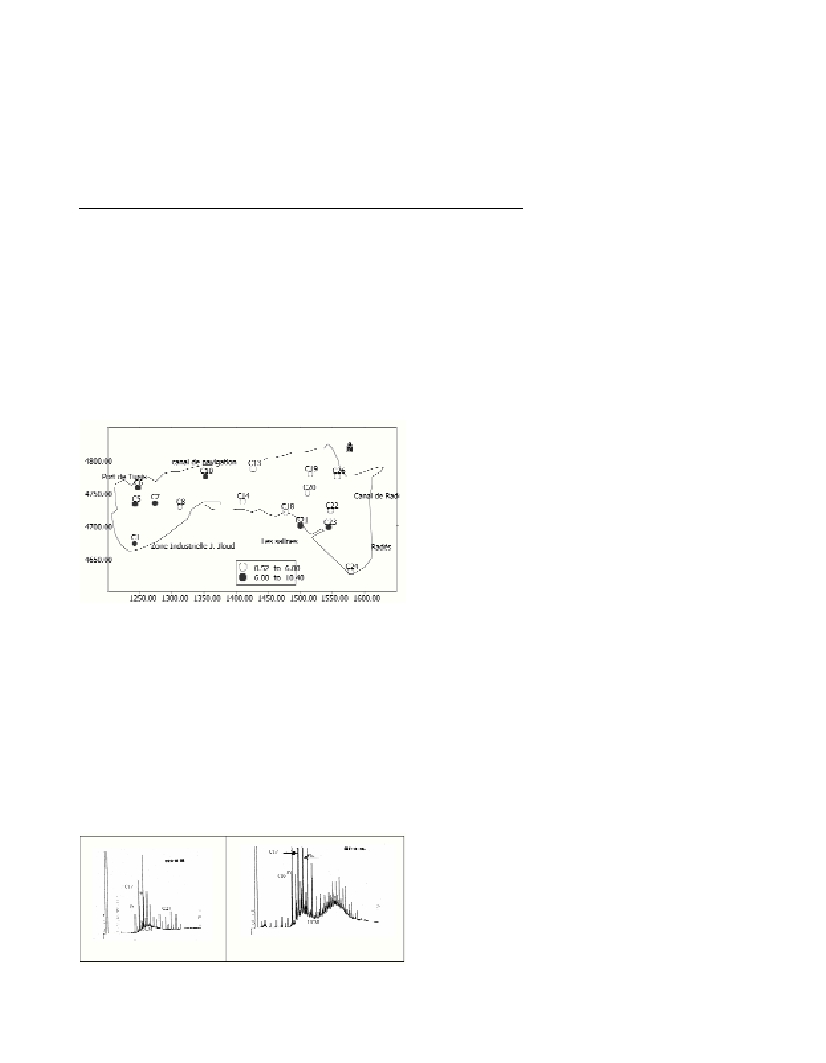Rapp. Comm. int. Mer Médit., 37,2004
230
PRELIMINARY STUDY OF ORIGIN AND DISTRIBUTION OF ORGANIC MATTER
IN SURFACE SEDIMENTS OF THE “LAC SUD” OF TUNIS
N. Ouertani*, R. Hamouda and H. Bélayouni
* Faculty of Sciences of Tunis, Geology department, Laboratory of Organic Geochemistry, Tunis, Tunisia - * nizarouertani@yahoo.fr
Abstract
Superficial bottom sediment samples inside the “Lac Sud” of Tunis were analysed for the TOC, free and potential hydrocarbon compounds, and
total hydrocarbons in order to establish the origin and the spatial distribution of organic matter. Attempt was made to the compositional patterns
of the aliphatic hydrocarbon to identify the petrogenic and biogenic sources of hydrocarbons.
Key words: recent sediments, Rock-Eval pyrolysis, TOC, gas chromatography, n-alkanes
The study of distribution and composition of organic matter in
surface sediments of “Lac sud” of Tunis(situated at the North-East of
Tunisia) allowed the individualization of 2 zones. The first one,
situated in the western part of the lake, presents high contents of TOC
(>6%, Fig. 1), high values of free hydrocarbons (S1= 12,51 mg of
hydrocarbons/g of sediment) and high values of total hydrocarbons
(from 5040 to 16380 ppm). Liquid chromatography shows that
saturated and aromatic hydrocarbons represent more than 50% of the
total hydrocarbon content. Chromatograms of the saturated fraction
(Fig. 2) show the presence of a regular distribution of n-alkanes
centred on n-C
25
with a large UCM indicating that the hydrocarbons
present have suffered a higher degree of biodegradation. All these
results confirm the presence of contamination by petroleum products
in these sediments (1, 2, 3, 4).
Fig. 1. Space distribution map of TOC values.
The second zone presents an organic matter inherited from the
original biomass with a mixed origin: continental and marine. These
sediments are characterised by: low contents of TOC (3%, Fig.1),
low values of S1 (< 1 mg of hydrocarbons/g of sediment), low values
of total hydrocarbons (340 to 1000 ppm). The lipid compounds vary
between 2 and 6% of TOC, these values characterize an organic
matter inherited from the original biomass. In fact, in the sediments
where the organic matter is still immature, lipid fraction does not
exceed, in general, 1 to 3 % of the TOC (2). The saturated fraction
(Fig.2) represents less than 10% of the total lipid content. N-alkanes
have a bimodal distribution with light n-alkanes ranging from n-C
15
,
to n-C
19
characteristic of benthic algae (5, 6, 7), and long chains (n-
C
25
to n-C
31
) having an odd/even predominance corresponding to n-
alkanes from high vascular plants (8, 7, 2).
Fig. 2. Gas chromatograms of the aliphatic fraction. Pr=pristane,
Ph=phytane, numbers refer to n-alkane chain length.
With these results, we can estimate the consequences of
biogeochemical processes on the hydrocarbon composition of the lake
and evaluate the impact of human and in particular harbour activity on
the organic contents of the sediments.
References
1-Eganhouse, R.P., and I.R. Kaplan, 1982. Extractable organic matter in
municipal wastewaters. 2. Hydrocarbons: molecular characterization.
Environ. Sci. Technol.,16:541-551.
2-Tissot B.P., et Welte D.H., 1984. Petroleum Formation and Occurrence.
2
ème
édition : Berlin, Springer-Verlag, 538 p.
3-Zheng G.J., Richardson B.J., 1999. Petroleum hydrocarbons and
polycyclic aromatic hydrocarbons in Hong Kong marine sediments.
Chemosphere, Vol. 38. N°11: 2625-2632.
4-Benalioulhaj S., Trichet J., Benalioulhaj N., Lucas J., Schreiber B.C.,
et Philp R.P., 2000. Black shales and phosphorites, results of differential
diagenetic evolution of organic matter in the Oulad Abdoun-Timahdit
sedimentary basin (MOROCCO). Marine Authigenesis: From Global to
Microbial, SEPM Special Publication No. 66: 427-444.
5-Lytle, J.S., T.F. Lytle, J.N. Gearing, and P.J. Gearing, 1979.
Hydrocarbons on benthic algae from the Eastern Gulf of Mexico. Mar.
Biol.,51: 279-288.
6-Youngblood, W.W., M. Blumer, R.L. Guillard, and F. Fiore, 1971.
Saturated and unsaturated hydrocarbons in marine benthic algae. Mar.
Biol.,8: 190-201
7-Farrington, J.W., and B.W. Tripp, 1977. Hydrocarbons in western
North Atlantic surface sediments. Geochim. Cosmochim. Acta,41: 1627-
1641.
8-Blumer, M, Guillard R.R.L., and Chase, T., 1971. Hydrocarbons of
marine phytoplankton. Mar. Biol., 8: 183-189.

